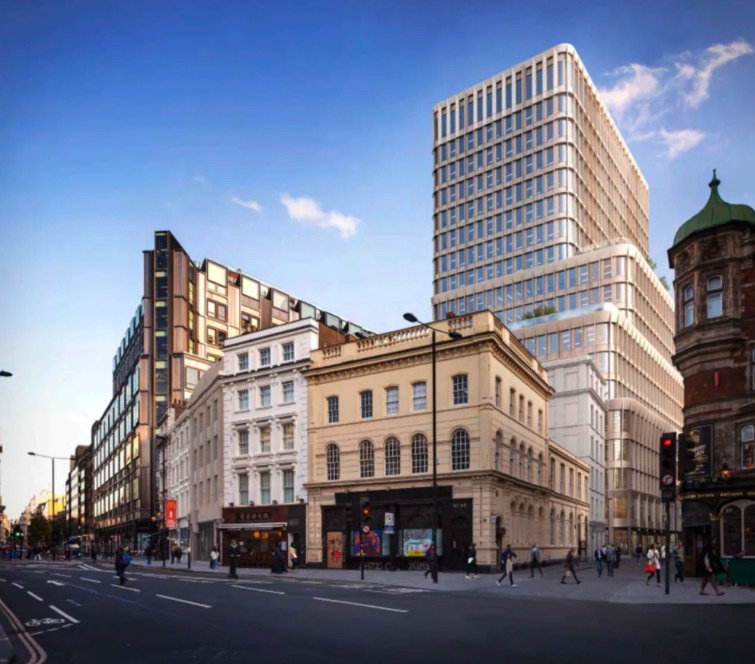Fight for central London is not over…
FORUM: The planning system is now facilitating development to suit the private sector, says Jim Monahan
Thursday, 12th December 2024 — By Jim Monahan

An impression of the planned tower development in Museum Street
IN November 2023 Camden Council granted planning permission for a hideous speculative tower block in Museum Street knowing that it would cause “significant harm” to London’s most important conservation area and result in the demolition of buildings of considerable merit that their own planning policies state should be protected.
Why did the planning officers recommend approval and why was it nodded through by the planning committee despite the scheme contradicting 40 explicit planning policies contained in the Camden Plan?
The planners claimed the developer’s proposal contained greater benefits than disbenefits and supported the view that the developer’s economic expectations precluded any other development options.
Simply put the economic demands of the developer took priority over Camden’s planning policies; no alternatives were considered, especially none coming from the public.
Since then efforts to stop the destructive development focused on endeavouring to get the courts to intervene.
Last week the legal action hit the buffers when the final application to the Court of Appeal was rejected by Kim, Lord Justice Lewison on the legal grounds that “it would have no real prospects of success”.
So what might be learned from the four-year campaign?
First and foremost the development industry clearly has complete dominance of the planning process. Economic viability (as defined by developers) trumps all policies concerning heritage, sustainability and social priorities.
The courts will not intervene so long as the planning authority have gone through a box-ticking exercise and can show that they have “considered” all relevant planning policies, irrespective of the conclusions.
The legal system accepts economic viability in the planning process and the courts are not equipped and certainly not inclined to interrogate developer’s economic “imperatives”.
Put in a nutshell the planning system is not what it originally set out to be, namely making decisions about our built environment for the greater good of the country, but is now facilitating development to suit the private sector.
There is a new narrative; words that have a clear meaning are twisted to mean the opposite; “affordable housing” (not affordable), “public realm” (private appropriation), “sustainability” (redevelop not reuse and adapt), “neighbourhood rejuvenation” (encourage land speculation), are just some more obvious examples.
And what of the local authority planners that are tasked to operate the system? Their overriding concern is to “deliver” large scale development come what may.
Their invitations to the public to comment on future plans are in bad taste. For why would anyone waste their time giving their views when the policies that result clearly have no meaning when they are disregarded at a drop of a hat when it suits?
The planners run a two-tier planning system: one for big developers and one for small schemes and individuals.
While individuals and small time developers can get hammered by the strict implementation of planning policies, large developers negotiate their way around the policies with the active support of the chief planning officers.
And for the democratic system?
Do local politicians actually care, especially in situations of massive majorities?
I am a Camden resident and in my view the consequence of the cynical disregard with which Camden’s political elite treat their constituents is dangerously corrosive and undermines democracy.
What is the point of partaking in the planning system when the whole process is dominated by a small clique running the council who totally ignore their colleagues and Camden residents’ views in favour of big time property developers?
Unfortunately we cannot expect a lead from our new government; recent planning decisions by Angela Rayner, like her approval of the M&S redevelopment in Oxford Street, show that the government’s overriding concern is about “growth” and “the private sector’s economic viability”.
On a personal level I want to thank the incredible public support and the countless donations I have received to take the battle to the courts.
I am so sorry I was not successful, but I am I sure the fight to protect the social character and heritage of central London is far from over.
Local authorities have largely abandoned any municipal pride and community concern when dealing with planning matters. It will be increasingly down to us Londoners to battle for higher values and aspirations and to take on the avarice of the property development market.
The Save Museum Street campaign is holding a vigil for the 12 trees lining the development site that are to be felled to enable the speculative office block monstrosity on December 18 at noon and we hope to festoon the doomed trees with Christmas decorations.
I hope you can come along however briefly; meet on the corner of High Holborn and Museum Street.
• Jim Monahan is an architect and founding member of the Covent Garden Neighbourhood Association.